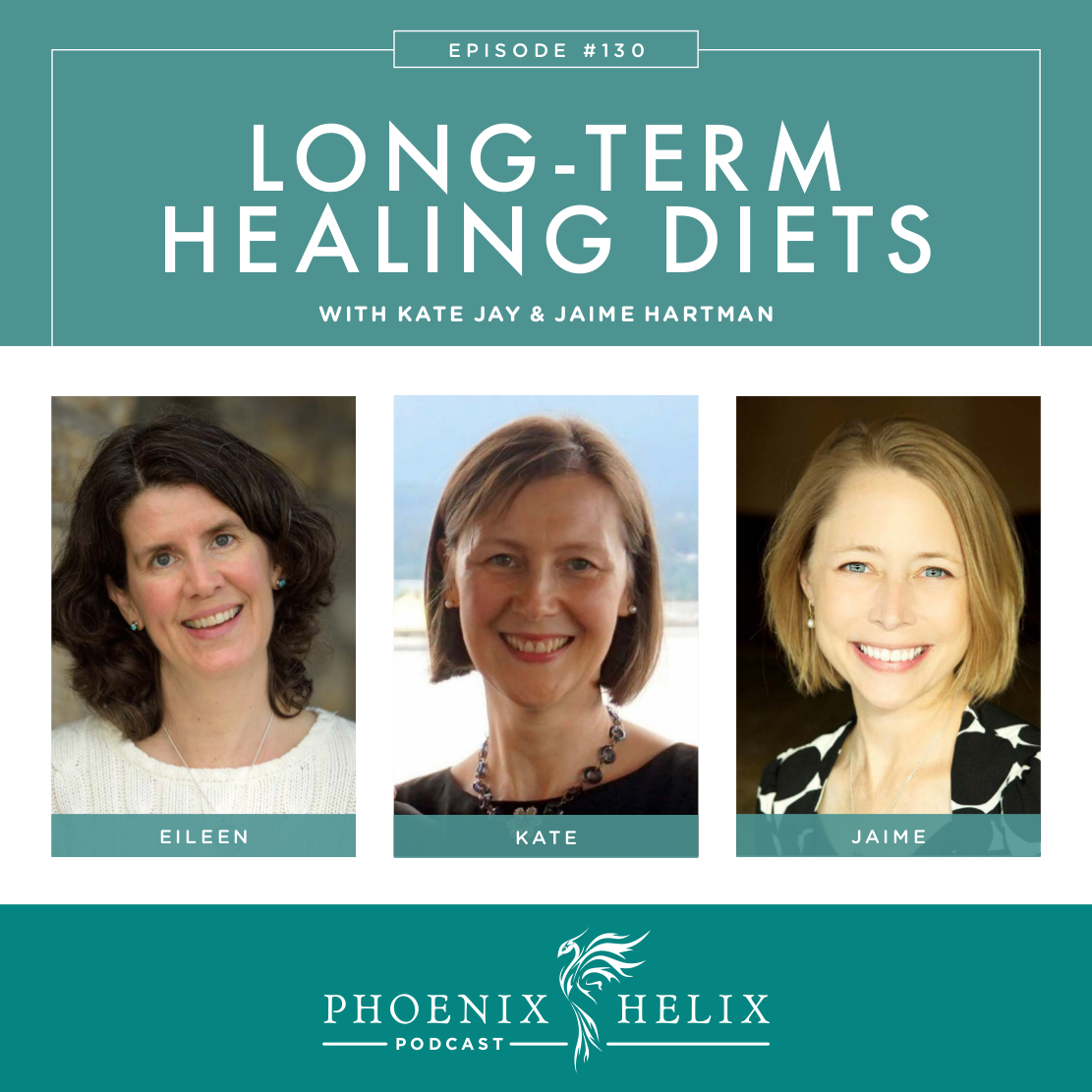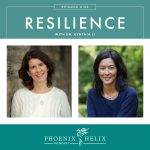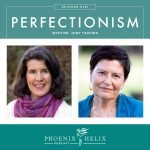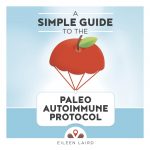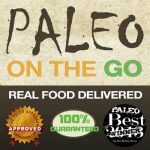What a Healing Diet & Lifestyle Looks Like Long-Term
This week marks the 5-year anniversary of this podcast! When I was thinking about how I wanted to celebrate, I decided to invite 2 friends onto the show who have been following a healing diet for 5 years or more. But that doesn’t mean our diet today looks the same as it did on day 1 of this journey. We’ve personalized it over the years, learning what does and doesn’t work for our unique bodies. We’ve had setbacks and recoveries, and we’ve learned to navigate our bodies’ changing needs.
Listen to the Show
- Subscribe to my podcast through your favorite podcast app: iTunes, Stitcher, Google, TuneIn, Spotify, Amazon, etc.
- You can also listen to the episode right here through the player below, and if you subscribe to my newsletter you’ll get notified of future episodes.
Podcast: Play in new window | Download
Show Notes
- Intro (0:00)
- It’s the 5-Year Anniversary of This Podcast! (0:55)
- Update: The celebration giveaway is over, but thanks to all of you for listening. Here’s to many years to come!
- Welcome to Our New Podcast Sponsor: Simply AIP (3:51)
- Update 2023: Simply AIP is no longer in business, but you can find AIP products at Fully Healthy.
- What Inspired Us to Make Dietary Changes? (5:45)
- Kate Jay is the blogger behind Healing Family Eats. Her health issues developed during her brother’s fight with cancer in 2008. Kate experienced severe anxiety (including paranoia and panic attacks), tingling throughout her body, irritable bowel syndrome, and joint pain and stiffness. While terrifying, the symptoms eventually went away and she was able to return to her normal life. Then in 2013, her symptoms returned. Because rheumatoid arthritis ran in her family, the joint pain was especially concerning. She turned to diet hoping she could stop the inflammation before it progressed to a diagnosis. She was ready to do whatever was necessary to feel better.
- Jaime Hartman is the blogger behind Gutsy By Nature. She was diagnosed with Crohn’s Disease at age 19. She asked her doctor if she needed to change her diet, and he said there was no scientific evidence proving Crohn’s is caused by anything you eat. So, Jaime followed the conventional medical paradigm instead. Over the next two decades, she tried multiple medications and had many ups and downs with her health, including numerous surgeries. In 2013, in spite of everything she tried, she was experiencing so much blood loss in her colon that she was severely anemic, requiring blood transfusions. It was at that point that she remembered a time between surgeries when she was unable to eat food and received IV nutrition instead. Her Crohn’s was stable during that period. She researched dietary interventions for Crohn’s disease and found some inspiring success stories online. She decided to give it 30 days. If at the end of that time, she noticed improvements, she would keep going. If not, she would re-evaluate. That’s been her philosophy ever since. That initial 30 days has turned into six years of feeling better. She combines diet plus medication to feel her best.
- Eileen Laird (your host): I experienced severe and rapid onset of rheumatoid arthritis in 2012, which disabled me within just a few months. It was an excruciatingly painful and scary time. Prior to that, I had prided myself on being someone who was easygoing and would eat anything. I felt bad for my friends who were gluten-free. It took a health crisis to inspire me to make a dietary change, but life was so hard now that changing my diet seemed easy by comparison. I did hope it was temporary, and that helped me get started. Once I realized it wasn’t temporary, I felt so much better that I didn’t mind continuing long-term.
- What Diets Did We Try? (17:26)
- Kate: The dietary changes in her family were first inspired by her son who was experiencing failure to thrive as well as mental health issues. The family made dietary changes together. They started with gluten-free/dairy-free, then progressed to the GAPS Diet. They saw improvements on GAPS, but some issues remained. That’s when Kate discovered the Paleo Autoimmune Protocol (AIP). After going AIP, her son’s mental health issues disappeared and he shot up in height. It turned out he was intolerant to eggs, which are a big part of the GAPS diet. Kate’s anxiety, joint pain, and brain fog all disappeared as well. For a while, they combined both protocols together (GAPS + AIP), which minimized starches in the diet. But they have since reintroduced starches successfully.
- Jaime: The transition to a healing diet was very challenging for Jaime. Like Eileen, she had prided herself on being a person who would eat anything. Becoming someone who needed to ask questions and have special attention paid to her food was a big change, and it took time to become comfortable with that. The first diet she tried was the Specific Carbohydrate Diet (SCD). It’s very similar to GAPS. Within just a few months, her anemia stabilized so she no longer needed transfusions. That was huge. However, she was already thin and started losing more weight, and simultaneously experienced high fatigue and started to develop depression as well. She knew something needed to change. So, after doing more research, she decided to go Paleo next. The two main changes she made were removing dairy from her diet and adding starches back in. All of the issues she developed on SCD resolved, and in addition, her digestion improved even more. (Note: it wasn’t just removing food that made the difference. Adding the starches is what resolved the fatigue and helped her regain weight.) Then, she learned about the AIP and wondered if she could improve her symptoms even more. This involved removing nightshades, eggs, nuts, and seeds from her diet. The result was a level of stability with her Crohn’s symptoms that she had never experienced before. It took her about a year to make all of these changes.
- Eileen: I started with gluten-free/sugar-free. My symptoms improved but only for a few days, and then they came rushing back. Next, I tried vegetarianism and then veganism. My inflammation continued to skyrocket. Then a friend of mine recommended the GAPS Diet. That was the first dietary intervention that made a lasting, positive difference. After months of worsening symptoms, I slowly started to improve. My flares dropped from every day to a few days per month, and they reduced in intensity as well. My baseline level of pain also reduced. I stayed with the GAPS diet until my improvements plateaued, about 5 months in. Then I added the AIP (continuing the GAPS low-starch recommendations). The results were dramatic. My flares stopped altogether, and my baseline pain dropped to a mild level. Simultaneously, my fatigue improved and my activities expanded exponentially. I don’t regret not going straight to the AIP, because for my personality I needed to take it in stages. The AIP was too intimidating for me at first, and I needed to see if something less restrictive would work. Also, by the time I finally went AIP, I understood the elimination phase didn’t last forever. Reintroductions were part of the process.
- Resources:
- Thank You to Our Podcast Sponsor – Paleo on the Go (37:19)
- A frozen meal delivery service, 100% of their menu is compliant with the elimination phase of the paleo autoimmune protocol (AIP). They have over 5o items, including entrees, side dishes, broth, AIP-friendly bacon, and desserts.
- Use the code PHOENIX for 10% off your first order.
- What Our Diets Look Like Today (38:47)
- Kate: The core of her diet is nutrient-dense AIP, but she has reintroduced a number of foods as well, including soaked and dehydrated nuts, soy-free eggs, and white rice. She tried reintroducing seeds, but they cause her digestive problems, and nightshades cause her joint pain so she continues to avoid those two food groups. Eggs took her a few years of healing to reintroduce successfully. Now, she tolerates them well as long as they are pastured and soy-free. (Research shows that when chickens are fed soy, it shows up in the eggs, so sometimes an egg intolerance is actually a soy intolerance.) Kate loves how clearly her body talks to her now, letting her know which foods are and aren’t beneficial for her.
- Jaime: She was able to reintroduce eggs successfully the first time she tried, and for Jaime, it doesn’t matter if they’re soy-free or not. She does try to buy pastured eggs for the best nutrition, but she appreciates the freedom to be able to eat all eggs. Her other successful reintroductions are coffee, most nuts and seeds (which she also soaks and dehydrates for optimal digestion), some gluten-free grains like white rice and gluten-free baking flours, and white potatoes (although that is the only nightshade she tolerates). Because she has some scar tissue from Crohn’s surgeries, digestive upset can have other causes and isn’t her strongest indicator for food intolerance. Instead, her strongest signs are extreme fatigue after eating, joint pain, and mood disruptions. The gut-mood connection is very strong for Jaime, and she finds it so empowering to be able to see and manage that for optimal mental health as well as physical.
- Eileen: In my first round of reintroductions I successfully added eggs, homemade chocolates, and small amounts of nuts/seeds back into my diet. Later, I added occasional white rice cooked in bone broth. The reintroductions that failed were nightshades and dairy (including ghee). I stayed with those reintroductions for years. Then, after making the decision to go on medication and achieving remission for the first time, my food tolerance expanded. I’m now able to have occasional dairy and nightshades which is a true pleasure, but I don’t make them a regular part of diet. I enjoy them as treats. While Jaime and Kate were able to reintroduce starches back into their diet, I do best on a low to moderate starch diet. I tolerate more starch now than I did 7 years ago, but if I eat too much at once or too many days in a row, my inflammation will increase.
- Why reintroduce foods at all? (1) Increased food freedom which makes travel, socializing, and meal planning easier. (2) Increased nutrient-density, because every food has a unique nutrient profile. If it’s not inflammatory for you, it can be a positive for your health. (3) The joy of adding new flavors to your life. (4) Also, when a food reintroduction fails, while grief is part of the process, knowledge is power. It lets you know which foods are connected to which symptoms.
- Resources:
- Paleo AIP Reintroduction Series (includes articles, podcasts, and interviews)
- What’s Up With White Rice?
- Soy-Free Eggs Online
- The Great Starch Experiment
- Navigating Setbacks (1:01:20)
- Kate: She recently experienced illness followed by travel, which led to some hair loss from the stress. She stopped the desserts and stepped up the nutrient-density, eating more liver, fermented foods, bone broth, and broccoli sprouts (her personal healing superfoods). She finds she recovers much more quickly with this extra focus on self-care.
- Jaime: Like Kate, she increases her nutrient-density if she experiences illness, flares, or added stress. She removes the “filler” foods that are neither negatives nor positives in her diet, and replaces them with healing foods instead, like liver, fermented foods, bone broth, and a wide variety of vegetables. She also tries to stay tuned into her body, catching the first hint of a problem before it reaches a crisis point. This knowledge is one of the gifts of following this lifestyle long-term. She starts her intervention early, using healing foods as a prevention as much as a treatment.
- Eileen: I do the same as Kate and Jaime, and in addition to focusing on nutrient-density, the variety of foods I eat is quite different when I’m in remission vs. a flare. I go back to avoiding all nightshades and dairy, sticking to the foods my body tolerates easily.
- Healing isn’t a permanent state. It’s a process, and part of being human is that we all have ups and downs, whether they be illness, flares, or times of extra stress. Don’t judge yourself for the setback. Simply support yourself through it.
- Resources:
- It’s Not All About the Food (1:07:23)
- Kate: When she first tried meditation, she didn’t like it all. But recently, she’s come to love it. It makes her feel more grounded, calm, and content throughout the day. Kate has a free guided meditation available through her website. She also has a bedtime routine which includes putting on amber glasses, listening to Jai-Jagdeesh, and doing 4-7-8 breathing to help her wind down for sleep.
- Jaime: Diet took her a long way, but it was getting a handle on stress and optimizing sleep that took her health to the best level she’s seen in decades. Quitting a high-powered job that involved lots of travel, and finding a job more conducive to a healthy lifestyle was a big part of that process.
- Eileen: In addition to what Kate and Jaime have already shared, one lifestyle change I love is taking one internet-free day every week (no computer and no smartphone). I reach a level of relaxation that is deeper than any other day. I’m also making more room for play and imperfection.
- Baby Steps to Lifestyle Changes:
- Stress: Start by identifying how stress appears in your life. That’s the first step in making choices to eliminate it where you can, and manage what remains.
- Sleep: Start by getting yourself on a consistent bedtime and waketime schedule, 7 days a week. This optimizes circadian rhythms which make it easier to fall asleep and stay asleep, and also supports your health overall.
- Deep Breathing: Left nostril breathing activates the relaxation response in the body, which supports digestion.
- Meditation: Listen to Ep. 91: Meditation for Fidgety Skeptics. It includes lots of tips for beginners.
- Outro (1:18:10)
- Kate Jay is an AIP Certified Coach and Nutritional Therapist. You can reach her through her blog, Healing Family Eats, where she also posts delicious AIP-friendly recipes.
- Jaime Hartman is also an AIP Certified Coach and Nutritional Therapist. You can reach her through her blog, Gutsy By Nature, where she also posts delicious AIP-friendly recipes.
- Eileen (your podcast host) is the author of multiple books, written to help people thrive with autoimmune disease. Learn more on the Books Page.
- If you like this podcast, follow or subscribe through your favorite podcast app. You can also subscribe to Eileen’s biweekly newsletter.
- Check out the entire archive of podcast episodes.
You May Also Be Interested In
Spreading the Word
If you like the podcast, please leave a positive review in iTunes. It would mean the world to me, and also helps others find the podcast. Here are some quick instructions using your iPhone:
- If you are already subscribed to my podcast: (1) Click the purple podcast icon. (2) At the bottom of the screen, click Library. (3) At the top of the screen, click Shows. (4) Click the Phoenix Helix podcast image. (5) Scroll down the page, and you’ll see Ratings and Reviews. Scroll down a little bit more and click on Write a Review. This will bring up the review screen. Tap 5 stars (if you love the podcast), and then click in the title box, and it will bring up the keyboard. Enter a title and short review. (6) Click Send in the upper right corner. (7) Thank you! Positive reviews give the podcast a higher search ranking in iTunes, helping people find it and letting them know it’s a quality podcast and worth their time to listen.
- If you haven’t subscribed to my podcast: (1) Click the purple podcast icon. (2) In the lower right corner, click the magnifying class. (3) Type Phoenix Helix in the search box. (4) Click the podcast cover in the Show list. (5) If you’d like to subscribe, click the + sign at the top of the screen. (6) To write a review, scroll down the page, and you’ll see Ratings and Reviews. Scroll down a little bit more and click on Write a Review. This will bring up the review screen. Tap 5 stars (if you love the podcast), and then click in the title box, and it will bring up the keyboard. Enter a title and short review. (7) Click Send in the upper right corner. (8) Thank you! Positive reviews give the podcast a higher search ranking in iTunes, helping people find it and letting them know it’s a quality podcast and worth their time to listen.

